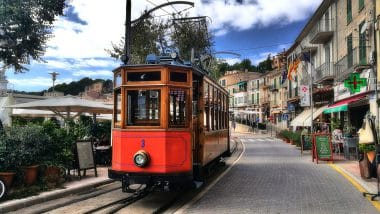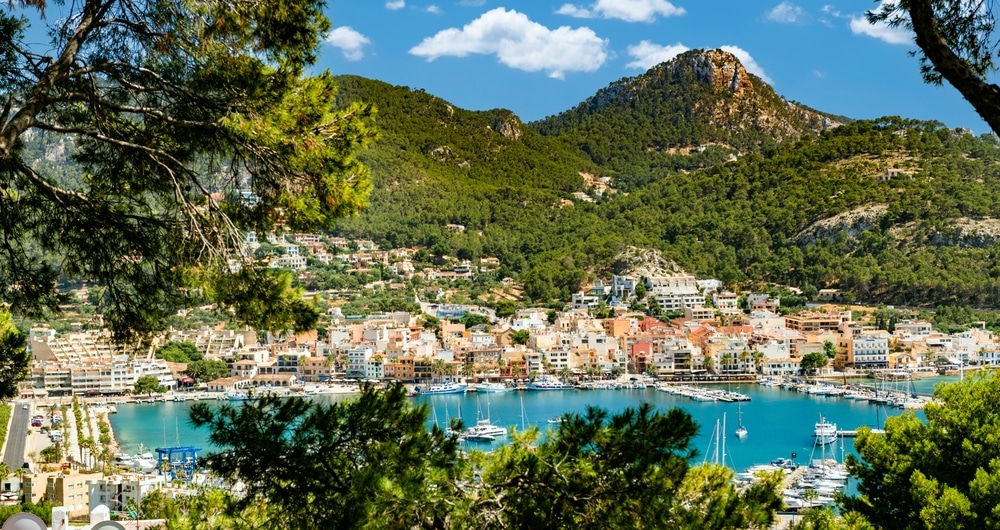The magic between Andratx and Sóller
Hiking solitude, peace, seclusion and tourist strongholds. Mallorca’s front side has a bit of everything. Mass tourism is a foreign word here and there are only a few beaches. For hikers, individual tourists and nature lovers, this piece of island is one of the most beautiful regions of Mallorca.
The rugged cliffs of the Tramuntana are probably the most spectacular part of Mallorca. With the surrounding picturesque mountain villages of Esporles, Banyalbufar, Deiá, Estellencs and Fornalutx, there is a wonderful scenery. The mountain landscape has been on the UNESCO World Heritage List since June 2011. Along the way, spectacular hiking trails, breathtaking views and fantastic sunsets are revealed.
No other area of Mallorca offers such beguiling mountain landscapes, such fascinating views of the sea and such picturesque villages as the northwest. The stretch of coast between the hamlet of Estellencs in the west and the monastery of Lluc in the east is particularly magical. Some of the biggest sights are located on the magnificent Ma-10 mountain road. Here you will find the country houses of Archduke Ludwig Salvator, the Charterhouse of Valldemossa and the friendly mountain villages. Often you only recognize other hidden places and places at second glance.
Robinsonades: the magical places in the northwest of the island
Andratx
Framed by pine-covered hills and towered over by a bulky fortified church, the small town of Andratx dozes away. The pretty harbour area of Port d’Andratx, on the other hand, is lively and captivates with an amusing atmosphere. In addition, the town is a second home for glossy celebrities and Rhenish dentists.
Sant Elm
The friendly village of Sant Elm greets you from the far southwest and is a wonderful starting point for excursions to the island of Dragonera. The small, tranquil seaside resort is only 8 kilometres from the country town of Andratx. Three hiking trails lead from Sant Elm to the former Trappist monastery of Sa Trapa.
Deiá

The picturesque mountain village with its narrow streets and medieval natural stone houses is much visited as a former “artists’ village”. Today, it is wealthy finca owners who set the tone. The gastronomy and hotel industry are correspondingly elaborate. The atmosphere is debatable. The small bay below the rugged scenery of the Tramuntana mountains offers a particularly charming ambience.
Valldemossa
Visitors coming from Palma up the curves may be speechless or breathless – that’s how breathtaking the view is on the way to the idyllic mountain village of Valldemossa. The green roof hood of the Carthusian monastery of Valldemossa can be seen from afar. The narrow houses with flowering gardens, crowned by the monastery and parish church, still fascinate today.
Here you can find the best paella with a sea view: The restaurant Sa Foradada clings to the rocks of the Foradada peninsula between Valldemossa and Deiá. It is the most secluded restaurant on the island and at the same time one of the most beautiful.
Estellencs / Banyalbufar
The two quiet villages cling to the mountain high above the sea. From the terraced slopes of the Tramuntana, the villages of Arab origin offer magnificent views of the sea. The village of Estellencs, founded by the Moors, gapes high above the deep blue sea. With its narrow streets, a breathtaking terraced landscape, the fortified church of Sant Joan and the tiny playa, Estellencs is one of the most beautiful villages in Mallorca. In Banyalbufar, everything the heart desired was grown as early as Roman times. Here, the small bathing bay is one of the most beautiful on the northwest coast.
Sóller

First of all, visitors to the town enjoy a fantastic sight: the peaks of the Serra de Tramuntana rise above the rooftops of Sóller . The small town forms the tourist center in the northwest and is not quite as idyllic as Deiá and Valldemossa. Visitors from all over the world cavort here all year round. Nestled in the tranquil mountains, the town is picturesquely situated between lemon and orange trees.
Tip: If you want to go even further to the sea from the Art Nouveau train station in Sóller , it is best to change to the tram. Since 1913, the railway has connected the town with its port of Port de Sóller, which is only a few kilometres away
Good to know: Archduke Ludwig Salvator was Mallorca’s first conservationist. He acquired several estates between Valldemossa and Deiá. On his land, he had forests reforested and hiking trails created. He also wrote detailed natural history studies on the Balearic Islands. He is still revered for it on the island today.
And there’s something else that makes the area so special: the road to Sa Calobra makes every motorized curve specialist sweat on the outside – and rejoice on the inside.
There is a wonderful short version of the region of the northwest by the French writer George Sand: “This landscape makes us mute. Everything that the painter or poet can dream of, nature has created in this place.”
Mallorca, Part 1 – Palma & the Southwest Coast
Mallorca, Part 3 – The North of Mallorca
Mallorca, Part 4 – The Southeast of Mallorca
Mallorca, Part 5: The centre of Mallorca
Können wir Ihnen helfen?
Benötigen Sie Unterstützung bei Ihrer Reiseplanung oder weitergehende Informationen zu einzelnen Reisezielen? Wir freuen uns über Ihre Kontaktaufnahme.


